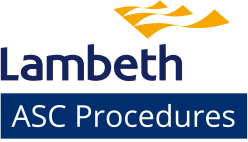This chapter is applicable to all staff in Adult Social Care.
Approval date: 05/03/2025.
CONTENTS
1. Sensory Impairment services
Lambeth residents with a sensory impairment, like others with a physical or mental health impairment that may require care and support services, are entitled to an assessment of their needs by adult social care. The Care Act Statutory Guidance also identifies responsibilities for the local authority for:
- completion of deaf / blind assessments;
- sight registers and certification for people with significant visual impairment;
- providing information and advice, particularly in an accessible format;
- visual rehabilitation/reablement to prevent, reduce, delay need for care and support.
The Sensory Team plays a vital role in supporting the continued wellbeing and independence of residents with sight and hearing loss, so they get the right support at the right time.
1.1 Sensory Team
The Sensory Team in Lambeth is embedded in Adult Social Care with the Technology Enabled Care Team and functions to:
- Process and manage Certificates of Visual Impairment (CVI) for adults and children. CVI’s are sent to the team directly via email by Eye Clinic Liaison Officers (ECLOs).
- Provide information and advice, signposting to relevant community and voluntary services, if required
- Provide specialist assessment for residents with sensory impairments: vision or both vision and hearing (dual sensory loss).
- Provide visual impairment rehabilitation such as activities of daily living and indoor/ outdoor mobility training to enable residents with visual loss difficulties to adapt to daily life and promote independence.
- Review due to change in personal or external circumstances or condition
- Provide equipment to promote independence in the home and outside.
2. Visual Impairment (VI)
The Team manages CVI’s and provides assessment and rehabilitation as required by a Visual Rehabilitation Specialist (VRS).
Visual Impairment (VI) Rehabilitation includes activities of daily living tasks and mobility/cane training. The duration of visual impairment rehabilitation and long cane training varies based on several factors, including the individual’s level of vision loss, their mobility skills, the complexity of their environment, and their personal progress. However, general timelines can be outlined as follows.
2.1 Visual Impairment Rehabilitation
Assessment and Planning: The initial assessment usually takes 1-2 sessions, depending on the individual’s needs. This includes evaluating their visual impairment, daily living skills, and mobility.
Rehabilitation Program: Depending on the individual’s specific needs, rehabilitation can range from several weeks to several months. Sessions might occur weekly or bi-weekly, typically lasting 1-2 hours each.
Short-Term Rehabilitation: For individuals with partial vision loss who require less intensive training, rehabilitation might take 4-6 weeks.
Longer-Term Rehabilitation: For individuals with significant or total vision loss, comprehensive rehabilitation can extend over a longer period of time, with ongoing support as they adjust to their new routines.
2.2 Long Cane Training
Initial Training: This usually starts with basic orientation and mobility training. Early stages focus on understanding the cane, practicing in familiar and safe environments, and building confidence.
Basic Proficiency: It often takes four to eight weeks for someone to develop basic proficiency in using a long cane, assuming they are attending regular training sessions once or twice a week.
Advanced Training: For more advanced skills, such as navigating complex environments, public transportation, or outdoor settings, training can extend to several months. This is particularly true if the individual needs to learn new routes, such as commuting to work or navigating busy urban areas.
Follow-Up and Support: Even after formal training, individuals may require periodic follow-up sessions to refine their skills, address new challenges, or refresh their knowledge.
For people with mild to moderate visual loss and no CVI, who may have care and support needs, assessment and support is can be provided via other teams as required i.e. reablement, occupational therapy and trusted assessors etc.
3. Hearing Impairment
For residents with hearing loss, the occupational therapy service and those trained as trusted assessors in the wider adult social care service assess and provide equipment and minor adaptations to support people with hearing loss to manage their daily living tasks. Equipment provided can include flashing doorbells, transmitters and vibrating pads linked to doors, phones, smoke detectors or other prescribed equipment to meet their needs.
In addition, Lambeth commissions the Royal Association for Deaf people (RAD), one day a week to provide support to deaf and hearing-impaired residents in a variety of ways. This includes help with filling out benefits forms, BSL translation, assistance to make calls, signposting to other support services.
4. Deafblind (Dual Sensory Loss)
Deafblind assessments are a specific type of Sensory Assessment for people who are experiencing dual sensory loss, hearing and visual, of any degree.
They would be provided with advice/information, rehabilitation and equipment. as described above and identified as part of the assessment.
Often residents who are deaf/blind may come into the service from another service such as Children or Learning Disabilities.
5. Referring into the Service
5.1 Vision impairment
Referrals into the team are completed via Mosaic by sending a task/request from the Contact/Referral to the worker, “Virtual Worker Sensory Team”.
The worker can be found by searching “Virtual” in first name, and “Sensory” in last name.
The referral task / request will be screened by the Sensory Team Manager or one of the sensory workers on duty and accepted or returned if not appropriate for the team.
5.2 Hearing impairment
If a person has a hearing impairment or is deaf, the following steps should be taken:
- Firstly, ask if they have seen an audiologist for hearing impairment, if not, they should go to their GP to get a referral and assessment for hearing aids.
- Trusted Assessors/ OTAs and OTs can provide equipment and also there are some standard pieces of hearing equipment i.e. flashing doorbells etc.
- The person can be sign-posted to the Royal Association for Deaf (RAD) for advice information and additional support.


